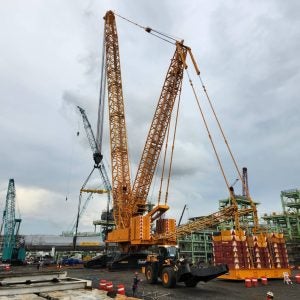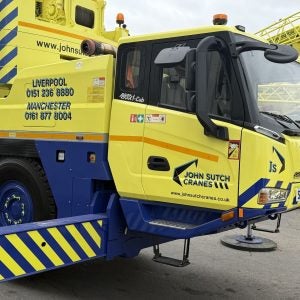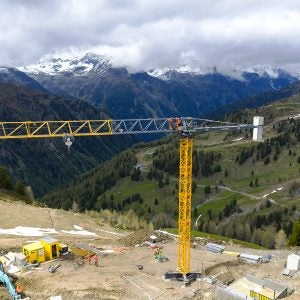Official statistics show that 86 new tower cranes of more than 200tm capacity were shipped from Europe to the USA during 1999.
Compared to the 4,000 or so tower cranes, of all sizes, that were sold in Europe last year, the USA is not yet a significant market. But for the first time in more than a decade, it is a growing market – and these days tower crane manufacturers are desperate for those.
In all probability, more large towers were sold in 1999 in the USA than in the previous 10 years put together.
The initial few German cranes that arrived in the USA in the late 1950s and early 1960s were followed up by a mini-boom led by Linden, which sold between 100 and 150 over five or six years. In the mid ’70s to early ’80s, Pecco – the US subsidiary of Germany’s Peiner – took over market leadership. Pecco then fell victim to the construction recession of the early 1980s, went bankrupt and its fleet was taken over by Morrow which has since dominated a rental market that until recently could only be described as slack. Morrow is Liebherr’s US dealer and has gradually increased the proportion of Liebherr cranes in its rental fleet, to the point where the brand is now dominant.
In 1995, after Peiner in Germany had been taken over by Preussag, it started again in the USA, through Noell Crane & Service (NCS), which now has about 40 cranes in its rental fleet.
With pushes led first by Linden and then Pecco/Peiner, the US tower crane market today is undergoing a third birth – and this time it is everyone’s turn to get into the action.
“Slowly the contractors, and especially the rental companies, have seen that there is less cost using a tower crane than a mobile crane on a long term contract,” says Terex Peiner sales director Frank Crombe.
“Tower cranes are now being accepted as a tool,” concurs Christian Chalupny, president of Liebherr distributor Morrow Equipment, the company with the USA’s largest tower rental fleet. “There’s a positive trend towards realising that the tower crane is an economic, low maintenance, quieter alternative.” Another factor may have been the ready availability of US-built crawler cranes which have often been used where tower cranes could possibly have been more productive. Crawlers are hard to beat for heavy lifting, but it is slowly being realised that tower cranes are cheaper for duty-cycle, long-reach work.
Liebherr and Peiner, along with Linden Comansa, are perhaps the best established tower crane brands in the USA. But more are coming. At Conexpo ’96 there was just one tower crane on show – a Liebherr. At Conexpo ’99 there were eight.
One of the more significant recent developments in the sector came in November 1998 when Terex acquired Peiner and took a major stake in Gru Comedil of Italy. The arrival of Terex has been followed by an upturn in interest in tower cranes in the USA. Given Terex’s cost-competitive strategy, this was perhaps to be expected. But some think that Terex has not played a significant role in growing the tower crane market. Instead, growth is attributed to the economy, to the reduced availability of crawlers, or to Morrow’s mighty resources being stretched, making room for competition.
“We hoped that Terex would grow the market and we would all benefit,” says a rival manufacturer. “But that’s not actually happened.” Partly, it is said, this is because of early organisational difficulties Terex faced at the outset. After the acquisitions, Terex Towers was established to promote, sell and support Peiner and Comedil cranes in the USA. Towards the end of 1999 it was reorganised and now looks after just the Peiner brand. The Comedil situation is not yet entirely clear: it is represented primarily by Florida-based MPS, established by Paul Studd and his father Mike (who runs Comedil’s UK dealer Select Tower Cranes), but this being Terex, MPS is not an exclusive distributor; Lewis Equipment in Dallas, Webb Crane in Denver and Sunnen Cranes in Washington state are also distributors.
Terex may have had teething troubles in the US tower crane business but it has not been without successes. As well as the aforementioned Comedil dealers, it has signed up Anthony Crane Rental as its main Peiner dealer. Anthony bought its first tower crane in January 1998, and now has more than 50 Peiners, plus others in its fleet through the acquisition of Carlisle. Lewis has also bought a couple of Peiners. With several companies running rental fleets of about 40 towers and Anthony looking to have 100 or more towers by next year, no longer is Morrow free to dominate the market like it has in the past with a market share of more than 50%. It remains the leading player by a long way, however, with a rental fleet of 340.
Crombe says that Peiner’s most successful models in the USA are the 300tm SK 315 (shown at Conexpo ’99) and the 400tm SK 405. It has also sold a few units of the even bigger 500tm SK 565. Brand new from Peiner is the SK 575, also 500tm rated but with a new jib. It has already sold two of these this year: one to Anthony and one to NCS.
Competition is opening up and no single brand dominates as it has in the past, but Liebherr retains a strong position thanks to its relationship with Morrow. In 1999 Morrow bought 30 new Liebherrs with capacities of more than 200tm, and it has a further 50 Liebherrs on order for the first half of this year (which will take its tower fleet to nearly 400 cranes). Crombe says that Peiner shipped 45 cranes to the USA in 1999 and he expects to sell about the same amount this year. This represents twice the business of previous years, he says. Studd reckons that he will sell 20 to 30 Comedil cranes in the USA this year, including 10 self-erectors.
And then there’s Potain. The French company continues to claim world market leadership (a claim fiercely challenged by Liebherr). It is has tried to attack the US market in the past and withdrawn. Now it is having another stab, led by former PPM man Dale Stoddard, lately of Bechtel. Potain has signed up Jake’s as its dealer for the west coast and the Las Vegas-based company has bought a number of MDT 412 models to promote. United Crane in Baltimore on the east coast has put five units on projects in its area in the past six months.
Stoddard reports that Potain has also sold cranes to Miller & Long in Washington DC, United Crane Rental in Baltimore, Webb Crane in Colorado, Sunnen Crane in Washington state, Horizon High Reach in California and Syracuse Equipment in New York state.
Linden Comansa remains a sound brand after all these years. Among those with whom it has maintained a long-standing relationship is the general contractor JE Dunn, which bought its first Linden more than 30 years ago. Today Dunn has five LC 2074s and three 8652s. Comansa export manager Christopher Dawes says that his company has “done reasonably well in the USA but we’ve been hampered a bit by delivery times because there’s been such a boom in Spain”.
Not long ago Linden Comansa produced the only flat-top tower crane seen in the USA. Now Comedil is generating interest for its CTT series. “The main market for us will be the topless CTT 331 and the CTT 561,” says Studd.






